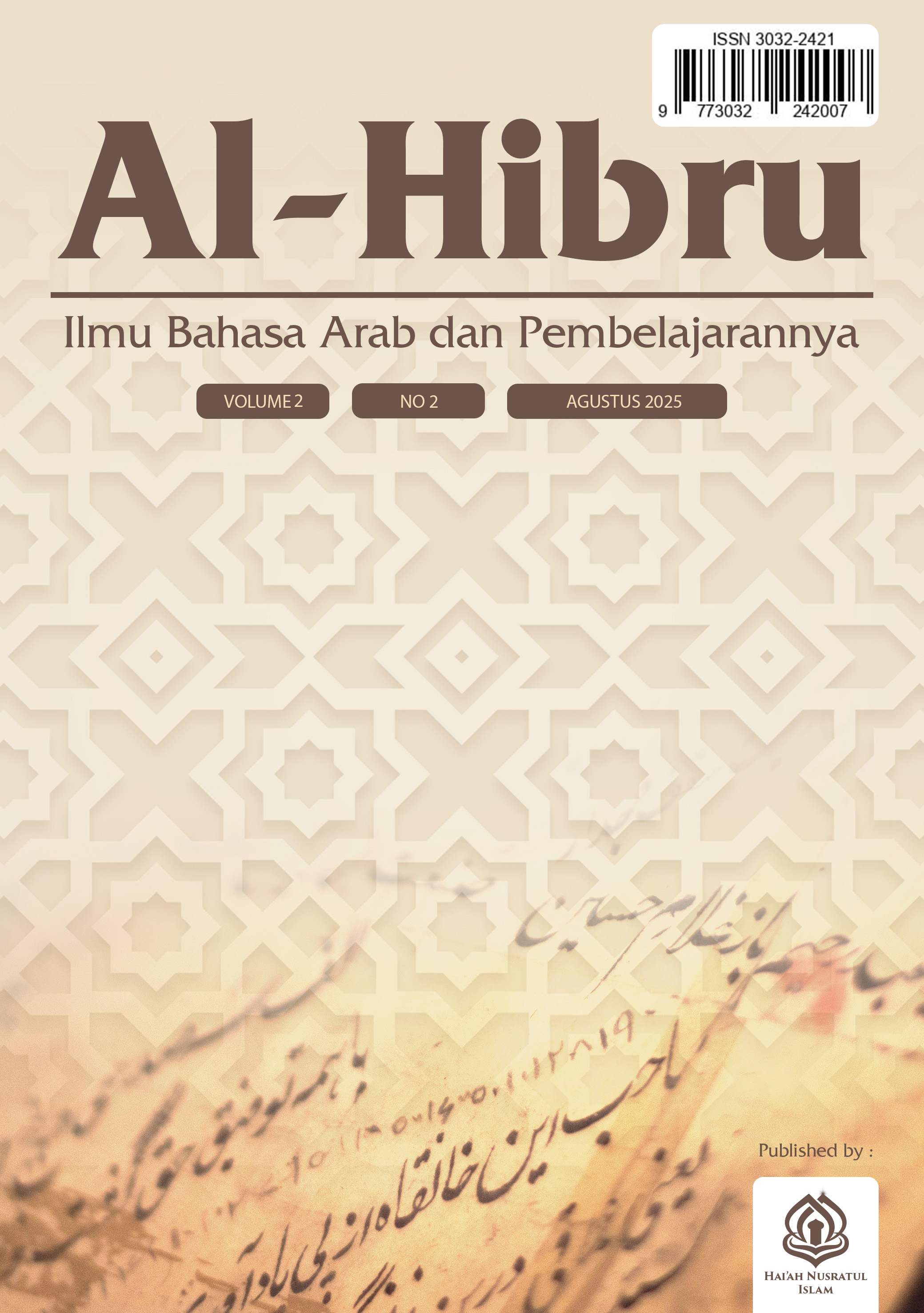THE PROBLEM OF SEMANTIC DIFFERENCES IN TRANSLATION: A STUDY FROM AHMAD MUKHTAR UMAR'S PERSPECTIVE
DOI:
https://doi.org/10.59548/hbr.v2i2.449Keywords:
Ahmad Mukhtar Umar, Problematics, Semantic, TranslationAbstract
This study examines semantic challenges in translation with an emphasis on problems related to ʿIlm al-Dilalah (the science of meaning). The method used is qualitative descriptive with a case study design, data collected from observations, interviews, and documents in the form of books, journals, and scientific papers on translation studies and semantic theory. Mukhtar Umar's views were highlighted, emphasizing that the core of the translation problem is the difficulty of choosing the right semantic equivalent. The findings suggest that the main problem lies in translator limitations in finding accurate and contextual equivalents of meanings. The problems that occur are differences in semantic range, contextual distribution, use of majas, partial classification differences, politeness and taboo terms in conversation. This research emphasizes the importance of deep semantic mastery for translators. This approach makes a significant contribution to the theoretical and practical aspects of translation.
References
Ansori, M. S. (2021). Perubahan Makna Bahasa: Semantik-Leksikologi. Semiotika: Jurnal Ilmu Sastra Dan Lingusitik, 22(2), 151–162. https://doi.org/https://doi.org/10.19184/semiotika.v22i2.24651
Apriliya, R., Simamora, A., Budiarti, V., & Syafitri, Y. D. T. (2020). Translation Based on Ogden and Richard’s Semantic Triangle Theory: How the Idea Is Connected to Real-World Objects. Jelita: Journal of English Language Teaching and Literature, 1(1), 20–26. https://jurnal.umbarru.ac.id/index.php/jelita/article/view/37
Bechko, Y. V. (2021). The Peculiarities of Functioning of Lexical-semantic Variants of the Noun Fire in the Process of Phraseological Unit Formation. Visnyk Universitetu Imeni Alfreda Nobelya. Seriya: Filologichni Nauki, 2021(1), 26–27. https://doi.org/10.32342/2523-4463-2021-1-21-14
Creswell, J. W., & Guetterman, T. C. (2024). Educational research: Planning, conducting, and evaluating quantitative and qualitative research. ERIC.
Denroche, C. (2024). Translating Figurative Language. Cognitive Linguistic Studies, 10(1), 1–22. https://doi.org/https://doi.org/10.1075/cogls.22011.den The
Goddard, C., & Wierzbicka, A. (2021). “We”: conceptual semantics, linguistic typology and social cognition. Language Sciences, 83, 101327. https://doi.org/https://doi.org/10.1016/j.langsci.2020.101327
Habib, I., & Rahmadewi, S. (2025). The Role of Euphemisms in Daily Communication : A Contrastive Study of Palembang and Minangkabau Languages. Jurnal Pendidikan Nusantara, 4(1), 37–45. https://doi.org/https://doi.org/10.55080/jpn.v4i1.177
Habib, I., Zaki, M., & Mustofa, S. (2025). Digital Adaption and Linguistic Change in Arabic Language Usage Through Social Media. Abjadia : International Journal of Education, 10(2), 318–328. https://doi.org/10.18860/abj.v10i2.32626
Harahap, P., Khairiyyah, R., & Nasution, S. (2024). Analisis Tantangan Bahasa dan Budaya dalam Penerjemahan Teks Arab di Media Sosial. Lisan An-Nathiq: Jurnal Bahasa Dan Pendidikan Bahasa Arab, 6(2), 102–117. https://doi.org/https://doi.org/10.53515/lan.v6i2.6182
Imamah, A. N. (2021). Penggunaan Gaya Bahasa Eufemisme pada Novel Ayah Karya Andrea Hirata. INSTITUT AGAMA ISLAM NEGERI MADURA.
Kwok, H. L., Laviosa, S., & Liu, K. (2023). Lexical simplification in learner translation: A corpus-based approach. Research in Corpus Linguistics, 11(2), 103–124. https://doi.org/10.32714/ricl.11.02.06
Mar, N. A., Kuraedah, S., & Haniah, H. (2022). Teori-teori Kontemporer dalam Penerjemahan. Journal of Arabic Education and Linguistics, 2(2), 85–96. https://doi.org/10.24252/jael.v2i2.32507
Mulyanie, J. (2022). Fenomena Penggunaan Majas Dalam Lagu-Lagu Pop Indonesia Dalam Kanal Youtube: Kajian Semantik Leksikal. Universitas Pendidikan Indonesia.
Nugraha, S., Luthfi, K. M., Arummi, A., Maret, U. S., Artikel, I., Arab, G. B., Penerjemahan, P., Penerjemahan, T., Budaya, F. I., & Maret, U. S. (2025). Peningkatan Keterampilan Penerjemahan Teks Akademik Indonesia-Arab untuk Penerjemah Pemula. Jurnal Inovasi Penelitian Dan Pengabdian Masyarakat, 5(1), 24–38. https://doi.org/https://doi.org/10.53621/jippmas.v5i1.411 ABSTRAK
Nuramila, N., & Daud, R. K. (2024). Perbandingan Makna Semantik Bahasa Indonesia Dengan Bahasa Daerah Gorontalo. BLAZE: Jurnal Bahasa Dan Sastra Dalam Pendidikan Linguistik Dan Pengembangan, 2(1), 98–103. https://doi.org/https://doi.org/10.59841/blaze.v2i1.843
Shan, X., Xu, Y., Wang, Y., Lin, Y.-S., & Bao, Y. (2025). Cross-Cultural Implications of Large Language Models: An Extended Comparative Analysis BT - HCI International 2024 – Late Breaking Papers (A. Coman, S. Vasilache, F. Fui-Hoon Nah, K. L. Siau, J. Wei, & G. Margetis (eds.); pp. 106–118). Springer Nature Switzerland. https://doi.org/https://doi.org/10.1007/978-3-031-76806-4_8
Sidiq, H. M., & Anis, M. Y. (2023). Arabic-Javanese Interrogative Sentence Translation Study in The Book of Khudz ’Aqīdataka min al-Kitābi wa al-Sunnah al-Shahīhah and Al-Hudā. Arabi : Journal of Arabic Studies, 8(1), 34–46. https://doi.org/10.24865/ajas.v8i1.552
Umar, A. M. (1998). Ilmu Dilalah, Cet. V.
Wang, S. (2020). Euphemism Translation from the Perspective of Skopostheorie. Theory and Practice in Language Studies, 10(9), 1173. https://doi.org/10.17507/tpls.1009.24
Wardhaugh, R., & Fuller, J. M. (2021). An introduction to sociolinguistics. John Wiley & Sons.
Yunianti, F. S., & Fajria, A. (2023). Tren Penelitian Terjemah Bahasa Arab Di Indonesia (Systematic Literature Review). Adabiyyāt: Jurnal Bahasa Dan Sastra, 7(1), 83. https://doi.org/10.14421/ajbs.2023.07015
Zulkarnain, L. P. (2023). Semantik Leksikal Pantun dalam Sastra Sasak. Jurnal Ilmiah Telaah, 8(1), 17. https://doi.org/https://doi.org/10.31764/telaah.v8i1.13360
Downloads
Published
How to Cite
Issue
Section
License
Copyright (c) 2025 Ikhwanul Habib, Sintya Rahmadewi, Taqiyuddin Kabalmay, Nur Hasan

This work is licensed under a Creative Commons Attribution 4.0 International License.
- Share — copy and redistribute the material in any medium or format for any purpose, even commercially.
- Adapt — remix, transform, and build upon the material for any purpose, even commercially.
- The licensor cannot revoke these freedoms as long as you follow the license terms.
Under the following terms:
- Attribution — You must give appropriate credit , provide a link to the license, and indicate if changes were made . You may do so in any reasonable manner, but not in any way that suggests the licensor endorses you or your use.
- No additional restrictions — You may not apply legal terms or technological measures that legally restrict others from doing anything the license permits.
Notices:
You do not have to comply with the license for elements of the material in the public domain or where your use is permitted by an applicable exception or limitation .
No warranties are given. The license may not give you all of the permissions necessary for your intended use. For example, other rights such as publicity, privacy, or moral rights may limit how you use the material.













